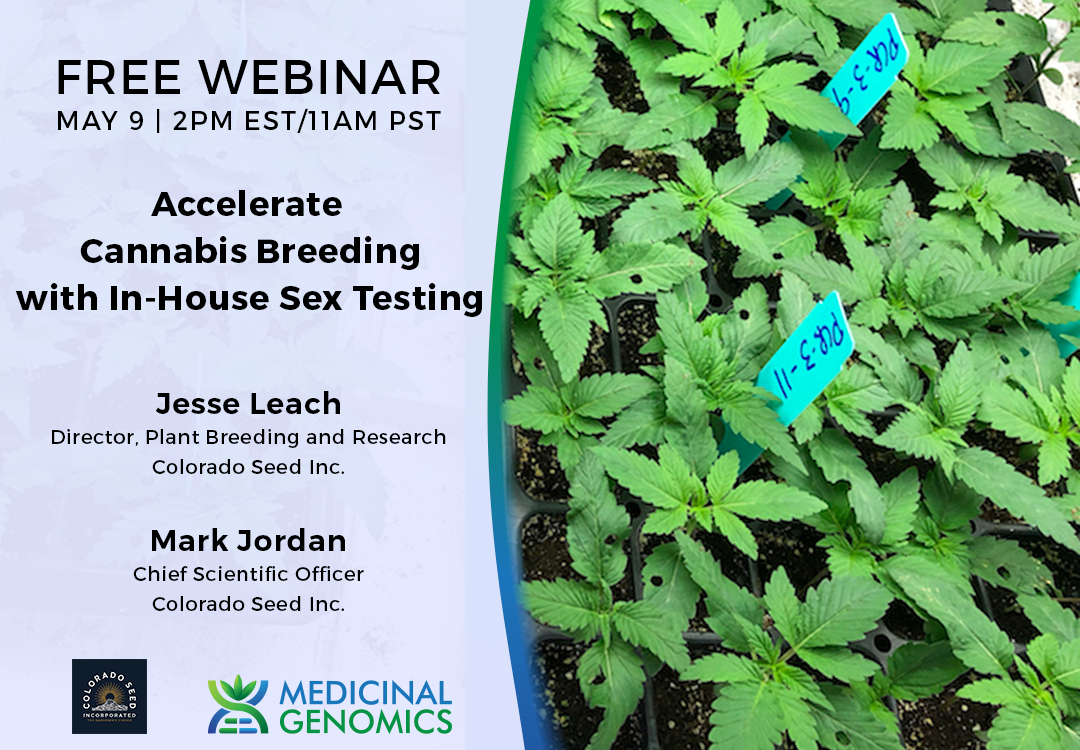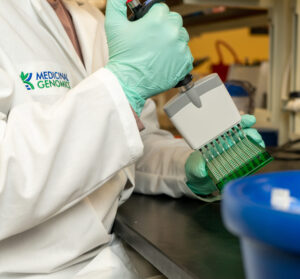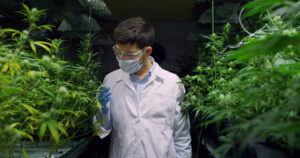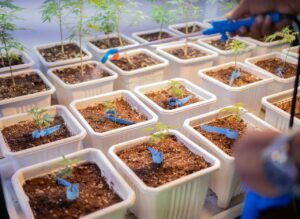We got a number of great questions for attendees at our webinar “Accelerate Cannabis Breeding with In-House Sex Testing“. So many, that we could not answer them all on the call. Luckily, Jesse Leach (Colorado Seeds), Mark Jordan (Colorado Seed) and Kevin McKernan (Medicinal Genomics) we kind enough to answer the remaining questions via email. Below are some of the questions they answered. If you didn’t attend the webinar live, you can view the recording on our Webinars page.
Plant Sex Questions
Q: How much stress does it cause females when you force males to show their sex by shortening photoperiod a few weeks after germination?
JL: From our experience, force flowering males can cause some stress that is passed on to the next generation, which can result in fewer females and more potential hermaphrodites in the next generation. I am not sure if this is epigenetic or variety dependent, but we have seen this pattern in our breeding data. We find it most beneficial to let the plants develop naturally so the phenotypic expression of the plants can be measured and accurate data can be collected. We allow the females to grow much larger and free of stress for the pollination. This allows time for our males to mature naturally so we can collect accurate data as well. Only the fittest plants will be selected to breed for the next generation and ensures that we have global population data for the line, as well as healthy plants to submit for fertilization.
Q: Is there any value to gender testing seedlings if cultivators grow exclusively form a female clone?
MJ: Seedlings and cuttings/clones are, by nature, two different things. Gender testing is extremely useful on seedlings to ensure yield. When cuttings are taken the sex of the plant doesn’t change although a herm could happen if there is enough epigenetic stress.
youPCR® Product Questions
Q: Explain the function & value of all of the components that make up your miniPCR Sample Starter Kit? Why buy it?
KM: The starter kit is meant to make it easy for you to get running without having to order things from 5 new vendors. It comes with pipettes, pipette tips, a desktop centrifuge, tubes, PCR-grade water, and lab accessories not found in most grows.
Q: Where does the 4% lost in efficacy come from?
KM: There are a few sources of error with youPCR®. Since the DNA prep is simple boil prep designed to the used in a grow, that tends to be the source of most errors. The most common error is from too much plant tissue, which presents inhibitors to the PCR reaction. These samples turn orange instead of a hard yellow. Other contaminants, like soap sprays used to fight infections, can also trigger an orange result. A few unique strains can trigger false negatives from exotic hemp lines that have a different Y chromosome. Some of these hemp genetics have gotten back into cannabis as folks have been breeding for CBDA. We usually rule out the funky genetics problem by running a SPRI-based DNA prep on the plant to rule out inhibitors. If the SPRI DNA doesn’t fix it, we sequence the strain to see if there are SNPs under our primers.
Q: How much equipment do we need to purchase and what is the cost for in-house youPCR®?
BA: We have put together “starter” kits including materials that you’ll need to get going with youPCR® point-of-grow testing for 200 samples. One is for customers using a 96-well thermal cycler ($1,800) and the other is for customers using the minPCR ($899). The starter kits do NOT include a thermal cycler or miniPCR, which must be purchased separately. The full list of what’s included in the kits is available on the webstore items.
Q: What additional assays are planned for the future of youPCR®?
KM: We have Fusarium, Pythium, Botrytis, Powdery mildew and some viral assays under development. We would love to have a THCV marker, but we need to self-fund a large sequencing project to find it. Open to collaborators on this.
Q: What gene sequences on the Y chromosome are the primers locating?
KM: We will have better gene annotation on the Y chromosome once the Pan Genome project is complete. At the moment we have a 1000 contigs on our Y chromosome map and have had to cherry-pick regions of the Y in common for most cultivars. This has led us down the path of redesigning this assay 4 times now. Each version of the test has become more tolerant of SNPs in the population. The first version of this test was presented at ICRS in 2016 and is 4 years old. We are 3 improvements beyond the first one we got to work.
Q: What is the cost difference between FemINDICAtor and YouPCR®?
KM: The assay costs are about the same. The FemINDICAtor comes with an internal positive control which can identify DNA prep errors very quickly. This internal control amplifies a gene in the cannabinoid synthase pathway and if it doesn’t show up, you didn’t get clean DNA into the reaction. This fluorescences in the HEX channel while the Y chromosome fluoresces in the FAM channel. To detect these 2 colors you need more sophisticated instrument. You need a qPCR instrument ($18K new and ~$10K used). The qPCR instruments are also capable of detecting 5 colors at once and support a dozen microbial assays we have made for them. They are the better high throughput option.
Cannabis Genetics Questions
Q: Please comment on CRISPR/Cas9?
KM: We are not running CRISPR/Cas9, but the tools are very powerful and we suspect now that the Jamaican Lion genome is public they will be in heavy use. CRISPR knock out of THCA has been proposed to make 100:1 CBDA:THCA. Not certain if this will work as CBDA synthase just might make small amounts of THCA as a by-product and pH and other environmental changes may be required to make CBDAS more specific. CRISPR/Cas9 is also being used for capturing 10kb-100kb targets out of the genome for more targeted sequencing of parts of the genome. Our general sense on CRISPR/Cas9 modification of cannabis is that if people are going to use, it would better if they did a scarless approach and introduced no foreign DNA into the plant. Moving cannabis genes around in the plant is a natural process often facilitated by breeding and viruses, but moving exogenous DNA into the plant needs to be approached with much more caution to avoid unforeseen events and allergen generation. While genome modification scares many people, once you take a deep dive in neurogenomics, you will see transposons in your neurons are shuffling the genomes in your brain cells. Each one of your neurons is like a GMO event! The bigger issue with GMO cannabis is that GMO plants tend to be more patentable and may be used to limit cannabis variety instead of promoting variety. https://link.springer.com/chapter/10.1007/978-3-319-48344-3_5 https://royalsocietypublishing.org/doi/full/10.1098/rsob.180074
Q: How will your company approach the growing interest in CBG and other secondary cannabinoids?
JL: We are definitely posed for specific chemotype breeding for secondary cannabinoids. Some of our varieties have tested extremely high in CBG and many other cannabinoids that are medically beneficial. Our interests are focused on the interaction of these cannabinoids and secondary metabolite research with some of our partners, which leads to a much better understanding of this plant. The genomics side of this, which Kevin and the Medicinal Genomics team are working on, plays a huge role in identifying these pathways for plant screening, and we hope to integrate more of this into our program as it develops.
KM: Seth Crawford presented CBGA breeding at CannMed last year. He basically crossed many Type III plants (CBDA-dominant) and screened the offspring for plants that had no CBDA gene with youPCR®. He verified his CBDA seedlings with Orange photonics. He now has a 14% CBGA 400:1 plant.
Q: Is there any plant DNA inside an empty shell?
KM: The seed coat has maternal DNA. The embryo has the DNA you want, but it is buried in a Megagametophyte that makes most of the globulin and Edestin required to feed the embryo once water hits. The megagametophyte has a different pollination event so its genome is assumed to be maternally identical but paternally different.
Q: Will Big Ag find its niche in the wellness industry by cultivating landraces?
KM: Big Ag is already in cannabis. I think their economies of scale will produce Bud Light. I drink Heady Topper. Their architecture can’t compete with craft breweries but they do occasionally buy the craft brewers. That being said, I think the innovation will be found in the craft growers.
Cultivation Questions
Q: Can CO2 sprays be effective for powdery mildew resistance for outdoor grows?
MJ: Fungus generally infects leaves that are rapidly growing. Something like CO2 makes the plant grow faster without incorporating potassium which a key component in plant defense. Based on that knowledge, I would assume it would increase the spread of PM.
KM: I’m only aware of sulfur burns. Didn’t know CO2 played a role. We have tools that can quantitate differential mold DNA for whatever technique you are investigating.
Q: Organic, Aquaponics, Aeroponics or all ?
MJ: Sustainable is your best bet. Organics are regulated by the USDA and EPA making it a political debate as to what is considered organic. Aquaponics are hard to maintain, Aeroponics have a problem where if the power goes out your grow can die in under 15min. although they can grow plants at hydroponics rates or faster.








